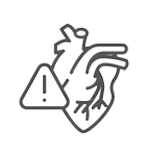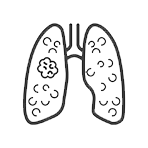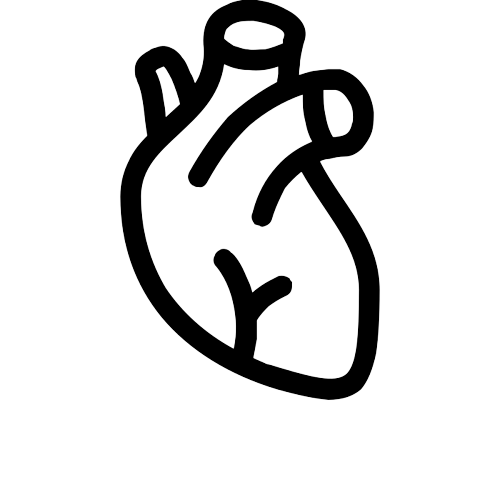Deep VEIN thrombosis
Deep vein thrombosis, or DVT, is a blood clot (thrombus) in a deep vein, usually in the legs. These clots need to be treated right away by a doctor.
Q & A
What is deep vein thrombosis (DVT)?
Deep vein thrombosis, or DVT, is a blood clot (thrombus) in a deep vein, usually in the legs. These clots need to be treated right away by a doctor.
These clots are dangerous because they can break off, travel through the bloodstream to the lungs, and block blood flow in the lungs (pulmonary embolism). Most of the time, pulmonary embolism is life-threatening. DVT can also cause problems that last for a long time. It could hurt the vein and make the area around the clot hurt, swell up, and change colour.
Most blood clots form in the veins of the calf and thigh. Less often, they form in the veins of the arm or pelvis. DVT in other parts of the body is also diagnosed and treated in the same way.
Why does it happen?
A blood clot in a deep vein (DVT) can be caused by slowed blood flow, which can happen when you don’t do much for a long time, or by abnormal clotting problems that make the blood clot too easily or too quickly. A blood clot can also be caused by surgery or damage to a blood vessel.
What are the symptoms?
One of the signs of DVT is swelling in the affected arm or leg. The leg or arm may swell, feel hot, or look red. It may hurt or feel sore in the calf or thigh. Pain could get worse, last longer, or stay the same. Symptoms may not show up if a blood clot is small.
How is it diagnosed?
If your doctor thinks you have DVT, you will probably have an ultrasound to measure how the blood moves through your veins and help find any clots that might be blocking the flow. You will also get a physical exam, during which the doctor will ask you about your health in the past.
How do you treat a DVT?
Blood thinners (anticoagulants) are often used to treat DVT for at least 3 months. How long you take them depends on your health, where the blood clot is, and how likely you are to get a pulmonary embolism. At home, you can take walks and prop your leg or arm up or raise it.
How can DVT be avoided?
You could take an anticoagulant medicine to help stop DVT. You can try to get out of bed often after being sick or having surgery. You might wear stockings that squeeze your legs. You could do exercises for your legs that can help the blood flow.
Cause
A blood clot in a deep vein (DVT) can be caused by:
Slowed blood flow. This can happen if you don’t do anything for a long time. For example, clots can form if you are paralysed, if you have to stay in bed, or if you have to sit for a long time on a plane or in a car.
Problems with the way the blood clots that cause it to clot too easily or too quickly. This could be caused by cancer or a clotting disorder that is passed down from your parents. Blood can also be more likely to clot during pregnancy, hormonal birth control, or hormone therapy.
Surgery or damage to the blood vessels could cause this. When veins are hurt, blood is more likely to clot right away.
What puts you at greater risk?
Many things can make you more likely to get a DVT. These things are:
- Being older than 40.
- Being overweight.
- not taking the blood-thinning medicine as prescribed.
- being sick for more than three days (such as in a hospital).
- Sitting for a long time, especially when travelling a long distance.
- Using hormones for birth control, being pregnant, or getting hormone therapy.
- Having had surgery or been hurt recently in the legs, hips, stomach, or brain.
- Having certain health problems, like cancer, a disease of the blood vessels, or a clotting disorder that runs in the family.
- Smoking.
Prevention
Work out the muscles in your lower legs to help the blood flow in your legs. Stretch your calves by pointing your toes up toward your head, then relax and do it again. When you have to sit for a long time, this is a good exercise to do.
After being sick or having surgery, get out of bed as soon as you can. If you have to stay in bed, do the leg exercise listed above every hour that you are awake.
Compression stockings are what you should wear. The fit of these stockings is tight at the feet and gets looser up the leg. A lot of doctors say that you should wear compression stockings on trips that last more than 8 hours.
On long trips, stop every so often. Just stop the car and get out. On long flights, walk up and down the aisle every hour and flex and point your feet every 20 minutes while you’re sitting.
If your doctor tells you to, take medicines that thin your blood after some kinds of surgery. If you are likely to get blood clots, you can also take medicines that thin your blood.
Symptoms
DVT doesn’t always show any signs. Or it may only cause small ones.
When signs and symptoms appear, they are:
- Leg or arm swelling where the injury is.
- The affected area is red and warm.
- Pain or being hurt. You might only feel pain when you touch the area or when you stand or move.
- When you have DVT, a pulmonary embolism is sometimes the first sign.
- If your doctor thinks you might have DVT, you will probably have an ultrasound test. You might have to take more tests.
What Happens
A blood clot in a deep vein (DVT) may break loose. If it does, it can go to the lungs and stop blood from getting to them (pulmonary embolism). This is an important matter.
Depending on where the blood clot is, it can increase or decrease the risk of a pulmonary embolism. If a blood clot is at or above the knee, it is more likely to cause a pulmonary embolism than if it is in the calf. But a pulmonary embolism can also be caused by a blood clot in a calf.
If you have DVT once, there is a chance that it will happen again. What caused the clot and how it was treated can affect your risk. Your doctor will give you treatment to try to keep you from getting clots again.
If you have had DVT, you have a risk of a painful complication called post-thrombotic syndrome. Medicines that stop blood from clotting may help lower the risk of this problem.
Tests and Exams
If your doctor thinks you have DVT, you will probably have an ultrasound to measure how the blood moves through your veins and help find any clots that might be blocking the flow.
The doctor will check you out to see if you need an ultrasound. This means your heart and lungs will be checked, and your legs will be looked at for signs of heat, swelling, bulging veins, or changes in skin colour.
When the results of an ultrasound aren’t clear, more tests may be done. Some of these are MRIs, CT scans, and D-dimer tests. These tests may help find a blood clot or rule it out.
Your doctor may test your lungs if he or she thinks you might have a pulmonary embolism.
A Look at the Treatment
When treating DVT, the main goals are:
- To prevent the blood clot from getting larger.
- To prevent the blood clot from traveling to the lungs (pulmonary embolism).
- To stop post-thrombotic syndrome from happening. This is a condition that can make the leg hurt, get sores, and swell up.
- To prevent blood clots from coming back.
- Treatment includes medicine and self-care.
- Medicine and self-care are both parts of the treatment.
Blood thinners
Most of the time, anticoagulant medicines are used to treat DVT. People often call these medicines “blood thinners,” but they don’t actually make the blood thinner. They help stop blood clots by making it take longer for a clot to form. They also stop blood clots that are already there from getting bigger.
You might need to take blood thinners for at least three months. How long it takes depends on your health and how likely you are to get a pulmonary embolism.
Other ways to treat
Some people in the hospital may get other kinds of care. Some of these treatments are thrombolytic drugs, thrombectomy, which is a surgery to remove the blood clot, and vena cava filters. But these treatments don’t happen very often. People who are at risk for serious problems from DVT might use them.
Self-care
Your doctor may also suggest that you take care of your symptoms on your own. These things are done:
- Several times a day, walk.
- Propping up (elevating) your leg or arm.
- Putting on tight stockings.
- Self-Care
The main parts of DVT treatment at home are:
- How to take blood thinners (anticoagulants) safely.
- Relieving symptoms.
- You can treat your DVT at home in a few ways.
- Use blood thinners safely.
- If you take an anticoagulant, which is also called a blood thinner, you need to do more to make sure you don’t have problems with bleeding.
- Avoid falling and getting hurt.
- Tell your doctors about any other medicines, vitamins, or supplements you are taking.
- If your doctor tells you to, get your blood checked often.
- If you can, walk several times a day.
- Symptoms like pain and swelling can be eased by walking.
- Elevate your leg or arm.
- This also makes pain and swelling go away.
- If your doctor tells you to, wear compression stockings.
Compression stockings are stockings that are made to fit a certain way. The foot is where they are the snuggest. As they go up your leg, they get less and less tight.
Your doctor might suggest that you take a nonsteroidal anti-inflammatory drug (NSAID) like ibuprofen to relieve pain. You shouldn’t take an NSAID unless your doctor says it’s okay.
Medicines
Blood-thinning medicines, which are also called anticoagulants, are used to prevent and treat DVT.
These medicines keep blood from clotting again. They also stop blood clots that are already there from getting bigger. They don’t remove clots that are already there.
Anticoagulants come in different forms. Talk to your doctor about what medicine you should take.
In the hospital, you might get an anticoagulant in the form of a pill, a shot, or an IV. You might give yourself shots for a few days after you get home. Most likely, you’ll take a pill for long-term care.
You might need to take blood thinners for at least three months. You might have to take them for a lot longer, or even for the rest of your life. How long it takes will depend on how healthy you are and how likely you are to get a pulmonary embolism.















